Written by Guest Contributor on The Prepper Journal.
Editors Note: A guest contribution from Evan Michaels at Know Prepare Survive to The Prepper Journal. And a Happy and Safe Veteran’s Day to all who have served, to those that currently serve and their loved ones who make their service possible with their love and support.
As always, if you have information for Preppers that you would like to share and possibly receive a $25 cash award as well as be entered into the Prepper Writing Contest with a chance to win one of three Amazon Gift Cards with the top prize being a $300 card to purchase your own prepping supplies, enter today.
There’s something raw and primitive about hunting. It takes us back to our roots.
I am not a fisherman. Or a doctor. Or a very good listener. Where was I going with that…
Right, fishing.
The closest I have ever been to catching a fish with a rod and reel was hooking a bat that decided to investigate my bait as I cast the line.
That is not to say that I have never eaten fish I caught myself.
I once caught a fish with a spear that I made myself. Which is so much more manly than a silly stick and string.
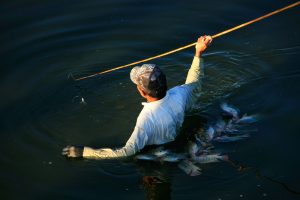
I know you probably think that I’m some amazing Bear Grylls-esque mountain man that would make Paul Bunyan look like a hipster. And you’d be mostly correct.
But if you want to learn how to make your own spear and hunt prey like an Alpha male (or female, I don’t discriminate) like me, you’ve come to the right place.
What Will You Need?
All you’re going to need to make your very own spear is a straight stick, a knife, and maybe some other stuff.
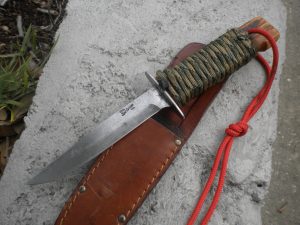
The stick is pretty obvious but you DO have a knife, right? Every survivalist should carry a knife with them at all times (except at sporting events and family gatherings).
If you call yourself a survivalist and you find yourself in the woods without a knife, you better have gotten kidnapped and left for dead. Because that’s the only excuse.
The Spear-it Stick
The most exciting method of hunting with a spear is to lash your knife to a branch and make a pokey stick out of it.
You may have a chance of losing your knife if you do this, so be sure to have a spare. If you only have one knife (tsk tsk), I’ll cover what you can do later.
To make a knife-stick, you only need three things:
A knife – You want to use a moderately large knife with a fixed blade, no pocket knives or folding blades.
A branch – The branch should be straight and of reasonable thickness. It should be comfortable to hold and not droop from the weight of the knife, so about 3 inches in diameter and three to five feet long. Hardwood is preferred. Fresh, green wood is not preferred.
Cord or other lashing material – Almost anything will work for this, from paracord to shoelaces to sinew.
How to Make a Hunting Spear/Knife Stick
Step 1. Prepare the branch. You want it to be as straight and smooth as possible, so trim off any bits that stick out and cut down any knots. You may also want to remove the bark. Woof woof.
Step 2. Make a shelf on the branch to hold the knife. Take the end of the wood that will hold the knife, and lay the knife handle against it, with the blade parallel to the wood and pointing away from it (duh). Mark how far down the knife lays on the branch.
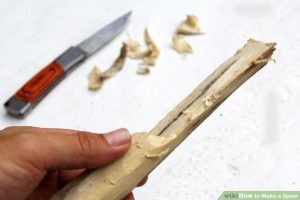
Now take your knife and use it to split the end of the wood down the middle. I would recommend batoning, a very useful skill for anyone who wants to use a knife in the woods.
If you are unfamiliar, basically you insert a fixed blade knife into the wood close to the base of the blade, then use a stick or mallet to strike the spine and handle to split the wood apart. Make sure to use a sturdy knife.
Once you reach the marked point, cut into the wood from the outside and break off that half. You should have a more or less L shape in the wood which fits your knife.
Step 3. Place the knife handle into that shelf, then take your cordage and lash the knife to the branch as securely as possible.
Seriously, wrap that sucker tight. If it is loose, it will affect your stabbing skills, you can lose your knife, and you’ll look like a total dweeb.
Congratulations! You have a spear you can use for hunting.
Pro Tip: If your knife starts to get dull after all of this sawing and hacking, you can use your watch band to sharpen it!
Different Spear Types
Primitive Spear
If you only have one knife and don’t want to attach it to the end of a stick, you can create a primitive spear.
That’s right, there’s an even more primitive way to make a spear than just tying a knife to a stick.
Step 1. Instead of creating the shelf and lashing the knife to the branch, you take one end of the branch and whittle it to a sharp point. Carve into the wood towards the tip, away from you.
Like before, you’re going to want to use a sturdy piece a wood that’s relatively straight, about as big around as a shovel handle and as long or longer than a shovel handle. You don’t have a shovel handle, do you? Because that would be perfect.
Step 2. When you’re whittling your spear point, be sure to make the pointy bit at least 6 inches long. Try to make it look like one of those yellow #2 pencils from school, but bigger.
Optional Step 3. For a stronger tip, insert the point under the coals of a campfire and slowly rotate. You do not want to burn the wood, but rather harden it using the heat. It still will not be as sharp as a knife spear and will not last as long, but should still be able to penetrate a deer’s hide.
Boar Spear
Wild pigs can be a good source of food, but they are a fair amount more dangerous than a lot of wild animals. A wounded boar is a vindictive beast, and they will move towards you, pushing the spear through themselves!
To keep the hunter safe, boar spears tend to have a cross brace a little ways below the head of the spear. To make one of these:
Step 1. Make a spear (primitive or knife-stick)
Step 2. Use your knife to create a V shaped notch in the wood of the spear shaft, and a corresponding V shaped notch in a branch of similar thickness (though only about a foot long.)
Step 3. Align the notches and lash the two pieces of wood together. Do not skimp on the cordage, as you want this brace to be strong. Just remember, it’s got to hold an angry wild pig with tusks from goring you. Kind of want to wrap it a little better now, huh?
Now, if you spear a boar and it tries to gore you, the brace will prevent it from getting close.
The brace also has the added advantage of preventing the spear from sticking too far into the animal, so you can pull it out and strike again if necessary.
A boar spear should also be thicker and longer than one made to be thrown.
Pro Tip: If a boar is charging at you, plant the butt of your spear into the ground and aim the pointy end at, you guessed it, the rampaging mutant pig. This will use the boar’s momentum to do all of the hard work of getting the pig on a stick for you and keep you from getting any pesky splinters. Or, you know, getting gored.
Fishing Spear
These spears are shorter and lighter than the other types, as you do not need a long reach or to keep an animal at bay.
Plus, you’re going to miss A LOT so the heavier your spear is, the faster you’re going to tire out.
You can use a lighter version of the primitive spear for this. Same concept, smaller stick.
When hunting with a fishing spear, you wait above the surface of the water, and try to impale fish as they swim under you.
Remember, light refracts as it travels through water. You will have to adjust your aim. Practice poking the spear in the water to learn how you will have to change your aim.
It might be good practice to “spear” underwater rocks. I would, ah, use one of your “mistake spears” for that, though.
Advanced Fishing Spear
Have a little bit more time, or having difficulty fishing with a simple spear? There is a more advanced fishing spear method. Creating it still requires using a knife, but you do not need to attach it to the shaft.
Step 1. Take your branch, and wrap a few inches of cord around, about a foot down from the end of the spear. This will help keep the shaft from splitting.
Step 2. Take your knife, and baton about halfway down to the cord. Remove your knife, now baton perpendicular to the split you created, so you create four points. Go all the way down to a few inches above the cord, then use your knife to baton the other pieces the rest of the way.
Step 3. Now take two twigs, about the size of your pinky and a little longer than the branch is wide, and jam them down between the split pieces of the wood so they splay out. Secure them in place with the cord.
Step 4. Now take your knife and carve sharp tips into the four points. With four times the tips, you are more likely to spear that fish!
Hunting with a Spear
There are two basic ways of hunting with a spear. They are similar to hunting with other weapons, but you have to get closer. These methods are stalking and still hunting.
Stalking is when you sneak up close to the animal. When using a spear, you have to get very close. This is easier with boar than with deer, especially during the heat of the day when the pigs are trying to cool themselves, but is still not easy.
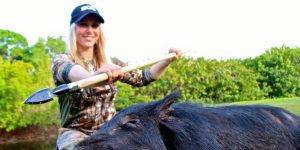
Still hunting is when you lay in wait for the prey to come to you. Learn where the deer trails are and lay in wait upwind of them so your stink doesn’t scare off the prey. That’s also good dating advice.
Hiding in a tree close to a deer trail may be a good idea as well, as deer have a tendency to not look for predators above them. The downside then is that you have a harder time striking at their vital organs.
No matter whether you are stalking or still hunting, there are also two ways you can use to strike your prey. Lunging with the spear is effective, and allows you to strike again if you miss or need to, but requires you to be VERY close.
Throwing your spear naturally lets you attack from a longer range, but if you miss then you will not have a second chance. Plus you just threw your weapon away, which is a bad idea if you face something which fights back, like boar.
To practice throwing your spear, create a second primitive spear and throw that one until you are comfortable.
Could you stalk or ambush prey with a just a knife, without a spear? Sure, it is possible. But it will be much more difficult and more dangerous. The shaft of the spear increases not only your reach but also your leverage, making the weapon much more effective.
So if you decide to hunt boar with just a knife, take out life insurance, write your will, have someone hold your beer, and send me the video.
Author Bio (unedited)
Evan Michaels is a jerk. He generally enjoys playing with fire, running with sharp objects, and watching SEC football. He also writes for Know Prepare Survive with some other jerks. You’d probably like it. (Editors Comment: How many times can YOU watch Alabama football?)
The post Hunting with Spears…. appeared first on The Prepper Journal.
from The Prepper Journal
Don't forget to visit the store and pick up some gear at The COR Outfitters. How prepared are you for emergencies?
#SurvivalFirestarter #SurvivalBugOutBackpack #PrepperSurvivalPack #SHTFGear #SHTFBag


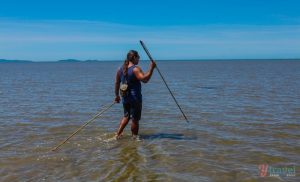

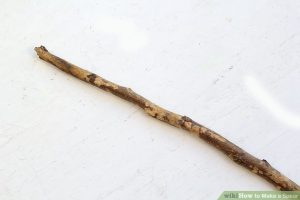
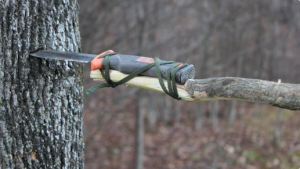


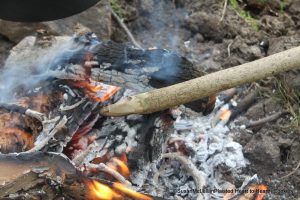
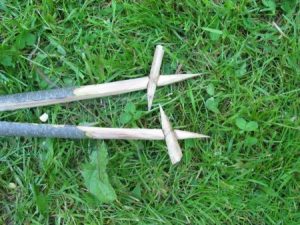

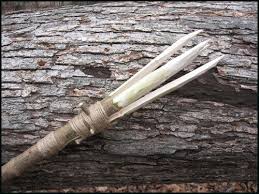
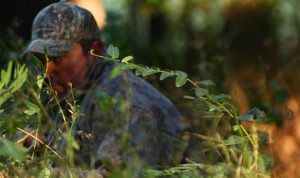
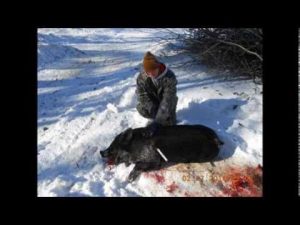
This comment has been removed by the author.
ReplyDeleteHey, that’s a precise piece of write-up on Hunting. To be honest, it would be a nice resource for me as I’ve been working on a similar subject area to create an eBook for some particular visitors of our company website,
ReplyDeletehttps://rangerexpert.com/best-hunting-rangefinders/